Related Research Articles

Black tie is a semi-formal Western dress code for evening events, originating in British and North American conventions for attire in the 19th century. In British English, the dress code is often referred to synecdochically by its principal element for men, the dinner suit or dinner jacket. In American English, the equivalent term tuxedo is common. The dinner suit is a black, midnight blue or white two- or three-piece suit, distinguished by satin or grosgrain jacket lapels and similar stripes along the outseam of the trousers. It is worn with a white dress shirt with standing or turndown collar and link cuffs, a black bow tie, typically an evening waistcoat or a cummerbund, and black patent leather dress shoes or court pumps. Accessories may include a semi-formal homburg, bowler, or boater hat. For women, an evening gown or other fashionable evening attire may be worn.
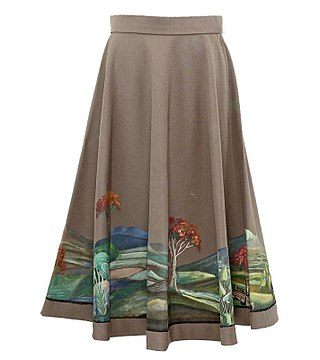
A skirt is the lower part of a dress or a separate outer garment that covers a person from the waist downwards.

A coat is typically an outer garment for the upper body, worn by any gender for warmth or fashion. Coats typically have long sleeves and are open down the front, and closing by means of buttons, zippers, hook-and-loop fasteners, toggles, a belt, or a combination of some of these. Other possible features include collars, shoulder straps, and hoods.
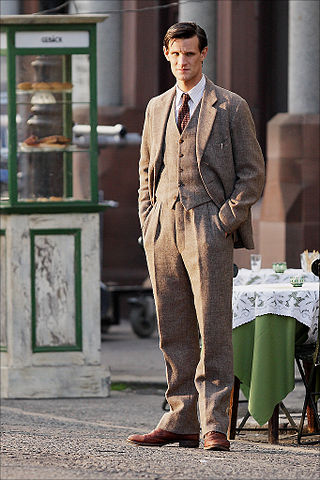
A suit, lounge suit, or business suit is a set of clothes comprising a suit jacket and trousers of identical textiles generally worn with a collared dress shirt, necktie, and dress shoes. A skirt suit is similar, but with a matching skirt instead of trousers. It is currently considered semi-formal wear or business wear in contemporary Western dress codes, however when the suit was originally developed it was considered an informal or more casual option compared to the prevailing clothing standards of aristocrats and businessmen. The lounge suit originated in 19th-century Britain as sportswear and British country clothing, which is why it was seen as more casual than citywear at that time, with the roots of the suit coming from early modern Western Europe formal court or military clothes. After replacing the black frock coat in the early 20th century as regular daywear, a sober one-coloured suit became known as a lounge suit.

A kurta is a loose collarless shirt or tunic worn in many regions of South Asia, and now also worn around the world. Tracing its roots to Central Asian nomadic tunics, or upper body garments, of the late-ancient- or early-medieval era, the kurta has evolved stylistically over the centuries, especially in South Asia, as a garment for everyday wear as well as for formal occasions.

A tunic is a garment for the body, usually simple in style, reaching from the shoulders to a length somewhere between the hips and the knees. The name derives from the Latin tunica, the basic garment worn by both men and women in Ancient Rome, which in turn was based on earlier Greek garments that covered wearers' waists.

1860s fashion in European and European-influenced countries is characterized by extremely full-skirted women's fashions relying on crinolines and hoops and the emergence of "alternative fashions" under the influence of the Artistic Dress movement.

Highland dress is the traditional, regional dress of the Highlands and Isles of Scotland. It is often characterised by tartan. Specific designs of shirt, jacket, bodice and headwear may also be worn along with clan badges and other devices indicating family and heritage.
Semi-formal wear or half dress is a grouping of dress codes indicating the sort of clothes worn to events with a level of formality between informal wear and formal wear. In the modern era, the typical interpretation for men is black tie for evening wear and black lounge suit for day wear, corresponded by either a pant suit or an evening gown for women.
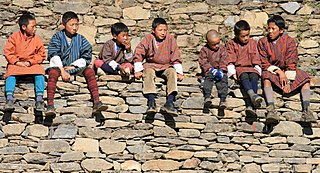
The gho or g'ô is the traditional and national dress for men in Bhutan. Introduced in the 17th century by Ngawang Namgyal, 1st Zhabdrung Rinpoche, to give the Ngalop people a more distinctive identity, it is a knee-length robe tied at the waist by a cloth belt known as the kera. On festive occasions, it is worn with a kabney.
A dolman is either a military shirt, or a jacket decorated with braiding, first worn by Hungarian hussars. The word is of Turkish origin, and after being adopted into Hungarian, has propagated to other languages. The garment was worn by peasants from the 16th century onward and eventually spread throughout the country, mainly within wealthy peasant circles. It reached people living in the poorest conditions only at the end of the 19th century.

Fashion in the 1970s was about individuality. In the early 1970s, Vogue proclaimed "There are no rules in the fashion game now" due to overproduction flooding the market with cheap synthetic clothing. Common items included mini skirts, bell-bottoms popularized by hippies, vintage clothing from the 1950s and earlier, and the androgynous glam rock and disco styles that introduced platform shoes, bright colors, glitter, and satin.

A dress is a garment traditionally worn by women or girls consisting of a skirt with an attached bodice. It consists of a top piece that covers the torso and hangs down over the legs. A dress can be any one-piece garment containing a skirt of any length, and can be formal or casual.
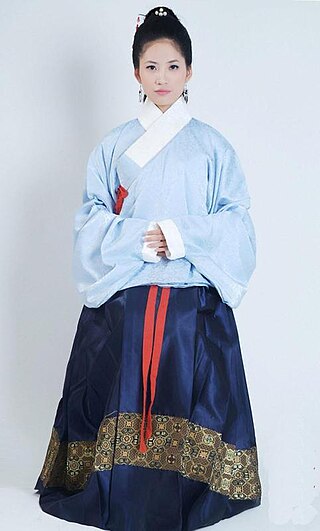
Ruqun is a set of attire in Hanfu which consists of a short jacket typically called ru worn under a long Chinese skirt called qun. However, when use as a general term, ruqun can broadly describe a set of attire which consists of a separated upper garment and a wrap-around lower skirt, or yichang, in which yi means the "upper garment" and the chang means the "lower garment". In a broad sense, ruqun can include the shanqun and aoqun in its definition.

Shalwar kameez is a traditional combination dress worn by men and women in South Asia, and Central Asia.

A caraco is a style of woman's jacket that was fashionable from the mid-18th to early 19th centuries. Caracos were thigh-length and opened in front, with tight three-quarter or long sleeves. Like gowns of the period, the back of the caraco could be fitted to the waist or could hang in pleats from the shoulder in the style of a sack back. Caracos were generally made of printed linen or cotton.

Traditional Irish clothing is the traditional attire which would have been worn historically by Irish people in Ireland. During the 16th-century Tudor conquest of Ireland, the Dublin Castle administration prohibited many of Ireland’s clothing traditions. A series of photos captured by French photographers Marguerite Mespoulet and Madeleine Mignon-Alba in 1913 included images of Irish people in traditional clothing. Some of these photos were taken in Claddagh, a town thought to have retained much of its traditional attire.

Shanku is a generic term which refers to a two-piece set of attire in Hanfu, which is typically composed of a youren yi, a Chinese upper garment which typically overlaps and closes on the right side which could be called shan, ru, ao, and a pair of long trousers ku. As a form of daily attire, the shanku was mainly worn by people from lower social status in China, such as labourers, shopkeepers, or retainers from wealthy household. The shanku was originally worn by both genders. Up until the mid-20th century, it was popular in China and outside of China where it was worn by overseas Chinese in countries, such as Singapore, Malaysia, Suriname, etc. It is still worn in present-day China and can be found in rural areas.
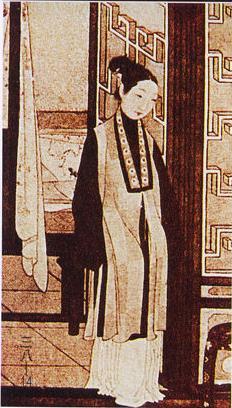
Bijia is a long, sleeveless jacket of Mongol origins which has opened side slits. The bijia started to be worn in the Yuan dynasty when it was designed by Empress Chabi. The bijia eventually became one of the most typical form of women's clothing item in the Ming dynasty and in the Qing dynasty. It is also a type of hanfu which has been revived in present days.

Ru, sometimes referred to as shan, ao, and yi, is a form of traditional Chinese upper garment, or coat, or jacket, which typically has a right closure; however, they may also have a front central opening. It is traditional everyday wear for women of the Han Chinese ethnic group. It can be worn in combination with a skirt in a style called ruqun, or a pair of trousers in a style called shanku.
References
- ↑ Freeman, Ruth Sunderlin (1978). Cavalcade of Dolls: Basic Source Book for Collectors. Century House Publishing Company. p. 301. ISBN 978-0-87282-001-2.
- ↑ McClellan, Elisabeth (1906). Historic Dress, 1607-1800: With an Introductory Chapter on Dress in the Spanish and French Settlements in Florida and Louisiana. Lane. p. 133.
- ↑ Earle, Alice Morse (2018-09-21). Two Centuries of Costume in America: Volume 1. BoD – Books on Demand. p. 105. ISBN 978-3-7340-5485-3.
